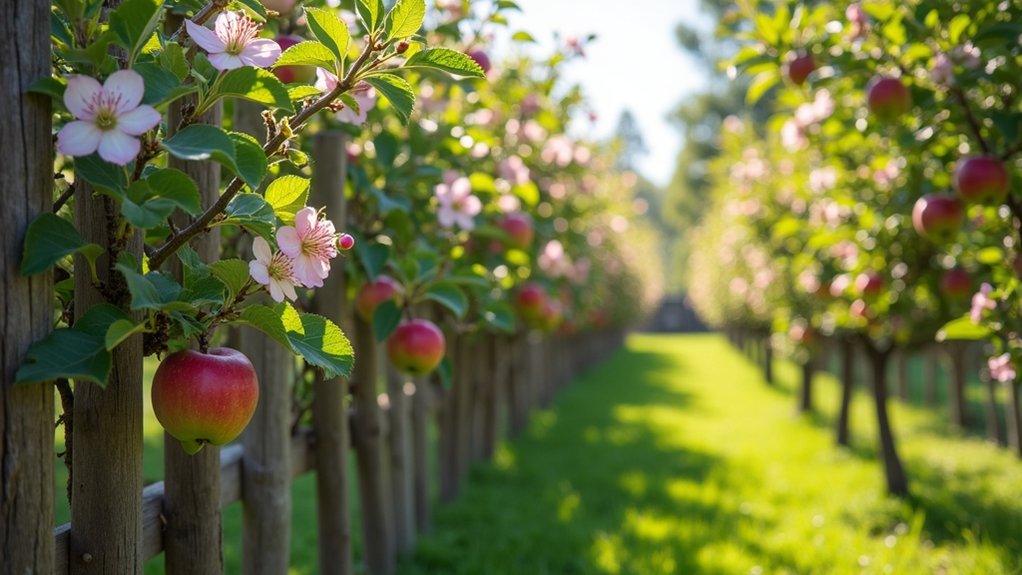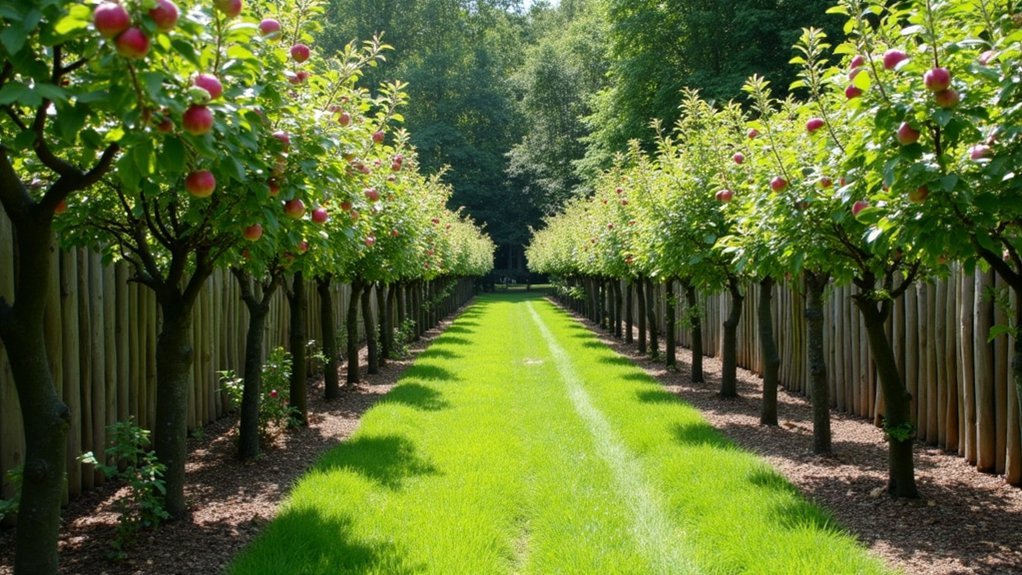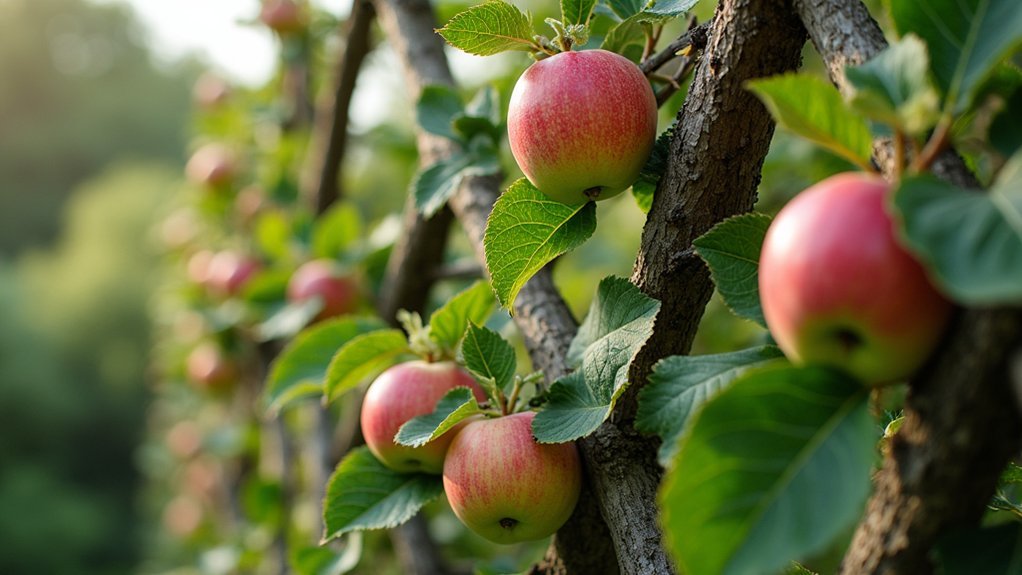Espaliered apple trees serve as perfect living fences by combining beauty and functionality in your garden. You’ll save valuable space while creating stunning visual interest throughout all seasons—from spring blossoms to fall fruit. These trained trees offer privacy, define boundaries, and produce sweet apples with enhanced sunlight exposure. They’re ideal for small gardens and urban lots, requiring minimal horizontal space. Discover how this centuries-old technique can transform your ordinary garden boundaries into productive, artistic elements.
The Space-Saving Magic of Espalier Training

While traditional apple trees demand substantial garden real estate, espaliered varieties transform vertical surfaces into productive growing zones.
Grow up, not out—espaliered apple trees turn walls and fences into fruit-bearing garden assets.
You’ll discover that this centuries-old technique allows apple trees to grow flat against walls or fences, turning unused vertical space into a fruitful asset.
The espalier method isn’t just a clever space saver for small gardens or urban lots—it’s also practical for improving your harvest.
The flat growing pattern enhances air circulation around branches, naturally reducing pest problems and disease occurrence.
Each branch receives maximum sunlight exposure, resulting in larger, sweeter fruits than conventional growing methods might produce.
Beyond their practical benefits, these trained trees serve as stunning ornamental plants, creating living fences that combine functionality with artistry in your garden design.
Creating a Four-Season Living Boundary
You’ll find that espalier apple trees maintain their elegant structure even in winter, especially when adorned with mini lights that highlight their architectural form against the stark landscape.
Throughout the year, these living boundaries transform with the seasons—from delicate spring blossoms to lush summer foliage, followed by the vibrant display of ripening fruit in autumn.
This continuous parade of changing colors and textures guarantees your garden boundary remains visually interesting and beautiful regardless of the season.
Winter Structure Remains Elegant
When winter strips away the foliage and fruit, espalier apple trees reveal their most distinctive quality—an elegant, sculptural framework that continues to serve as a beautiful living boundary.
The horizontal branches create a stunning lattice effect that maintains visual interest in your garden throughout the dormant season.
Your espalier tree’s winter structure offers multiple benefits:
- The geometric support structure creates an artistic element that stands out against winter landscapes.
- You can transform the bare framework with decorative white mini lights for a magical evening glow.
- The small space-friendly design continues to function as a windbreak, improving microclimates for neighboring plants.
Even in winter’s starkness, your living fence remains both functional and visually striking—proving that espalier trees truly provide four-season appeal in your garden.
Seasonal Colors Change Beautifully
The structural elegance of winter’s bare branches only hints at the visual feast your espalier apple fence provides throughout the year. These living fences transform dramatically through seasons, offering a beautiful display of changing colors and textures for your landscape.
| Season | Espalier Apple Fence Features |
|---|---|
| Spring | Vibrant blossoms create stunning floral displays |
| Summer | Lush green foliage forms a textured privacy screen |
| Fall | Leaves transform into red, orange, and yellow hues |
| Winter | Bare branches can be adorned with mini lights |
Your espaliered trees deliver a four-season boundary that’s both functional and visually enchanting. As seasonal colors shift from spring’s delicate blooms to summer’s verdant foliage, autumn’s fiery palette, and winter’s sculptural simplicity, you’ll enjoy a constantly evolving natural artwork that enhances your garden year-round.
Step-by-Step Guide to Planting Your Apple Fence

Creating an apple fence through espalier techniques requires careful planning before the first shovel hits the ground.
Select a location with at least 6 hours of direct sunlight and good air circulation, keeping apple trees 4-6 inches away from walls. Use chalk to outline your design, ensuring proper spacing for growth.
Prepare for planting success with these key steps:
- Dig holes twice the rootball size and enrich the soil with compost for ideal drainage and nutrients.
- Secure your trees to the wire support system using soft vinyl stretch ties, aligning each trunk with the center vertical wire.
- Maintain vertical growth through regular pruning (at least three times per season) to direct branches along horizontal wires.
This training system creates both a functional boundary and a stunning living fence.
Selecting the Best Apple Varieties for Espalier Fencing
Choosing the right apple varieties forms the foundation of a successful espalier fence project. Arkansas Black, Red Delicious, and Empire stand out as excellent choices, offering both delicious fruit and visual appeal for your living boundary.
When selecting apple trees for your espalier design, prioritize cultivars with flexible branches and strong structure that can be easily trained along support systems. Dwarf apple cultivars are particularly ideal as they maintain manageable proportions while providing earlier fruit production than standard trees.
Your espalier fence won’t just look beautiful—it’ll produce superior apples too. The training method enhances sunlight exposure and improves airflow, resulting in sweeter, larger fruit.
Remember to take into account your local climate and select disease-resistant varieties to guarantee your living fence thrives in your specific environment.
Maintenance and Pruning for Long-Term Success

While establishing your espalier apple fence may seem challenging at first, maintaining its elegant form requires a consistent pruning schedule that becomes second nature over time.
The rhythmic discipline of espalier maintenance transforms a daunting technique into a meditative seasonal ritual.
You’ll need to prune your trees three times each season—June 1, July 1, and August 1—to direct growth and maintain their beautiful horizontal structure.
For best results:
- Select specific buds for future cordons and cut back new growth to focus energy on developing lower tiers first
- Secure branches to wire supports to encourage horizontal growth, maximizing sunlight exposure and fruit production
- Stop all pruning 6-8 weeks before first frost to prevent damage to new growth
Remember to maintain well-drained, loamy soil and verify your espalier fence receives 6-8 hours of daily sunlight for long-term success.
Harvesting Benefits: Beyond Beauty to Bounty
The aesthetic charm of your espalier apple fence represents just half of its appeal—the true reward comes at harvest time.
When you train fruit trees in horizontal tiers, you’ll notice markedly larger, sweeter apples thanks to improved sunlight exposure throughout the canopy. This strategic support system encourages branches to produce more fruit than conventional vertical growth patterns.
Your harvest quality will exceed that of traditional orchards as regular pruning stimulates fruiting spur development. You’ll also maximize your garden’s potential by planting multiple varieties closer together, ensuring diverse harvests from minimal space.
Perhaps most impressive is the longevity of your living fence—with proper care, espaliered apple trees can produce bountiful harvests for over 150 years, making them an extraordinary investment that keeps giving season after season.
Design Inspiration: Espalier Patterns for Your Property

You’ll find endless inspiration in traditional geometric espalier forms like the sleek cordon, elegant fan, or dramatic candelabra patterns that define your property boundaries with living architecture.
Transform ordinary fence lines into productive Belgian fence lattices that create semi-transparent divisions while maintaining openness between garden rooms.
Your vertical space becomes a living wall when you train apple trees against existing structures, turning bland surfaces into productive, beautiful design elements that change with the seasons.
Traditional Geometric Forms
Many gardeners find that traditional geometric forms offer the perfect balance of artistry and functionality when designing espalier apple trees.
The three most celebrated designs—cordon, fan, and candelabra—each serve specific purposes in your garden landscape.
- Cordon patterns feature horizontal branches that maximize sunlight exposure for apple trees, dramatically increasing your fruit production while maintaining a clean, linear aesthetic.
- Fan-shaped espaliers create visual impact with branches radiating at 45-degree angles, improving air circulation around your developing fruit.
- Candelabra designs reach impressive heights of 8½ feet, providing vertical interest as a stunning focal point in your garden.
For those seeking both beauty and function, consider the Belgian fence technique, which weaves V-shaped espaliers into an intricate lattice that allows light and air to pass through.
Property Boundary Designs
When designed thoughtfully, espalier apple trees transform ordinary property lines into stunning living fences that serve multiple purposes simultaneously. By utilizing the common espalier patterns like cordons and fans along your boundary, you’ll maximize space while creating an aesthetically pleasing barrier that produces fruit.
Consider training your trees against a flat wall or installing trellises along property lines to support their horizontal growth. This approach not only enhances privacy but also increases fruit production as the branches receive ideal sunlight exposure.
You’ll need to prune regularly to keep your living fence in shape, but the effort yields both beautiful structure and abundant harvests.
Your property boundary becomes more than a divider—it’s a productive, ornamental feature that defines your outdoor space with purpose and style.
Living Wall Concepts
The art of espalier transforms apple trees into living architecture, offering homeowners distinctive patterns that double as functional property dividers.
In narrow spaces where traditional fencing might feel imposing, these living sculptures create breathtaking boundaries that produce fruit.
Training new growth along vertical wires allows you to customize your living wall in various eye-catching designs:
- Cordon patterns – Simple horizontal branches extending 6 feet in each direction, perfect for straight garden borders.
- Fan designs – Dramatically spreading branches that create visual interest against plain walls.
- Belgian fence or candelabra styles – Intricate patterns that elevate your landscape design while defining property lines.
You’ll enjoy spring blossoms, summer shade, and fall harvests while maintaining improved air circulation that naturally reduces pest problems in your garden.
Frequently Asked Questions
What Are the Disadvantages of Espalier Trees?
You’ll need to commit to intensive pruning three times yearly, wait years for establishment, accept reduced yields, risk disease from poor air circulation, and invest more upfront for support structures.
What Is the Purpose of an Espalier?
The purpose of an espalier is to train your fruit trees to grow flat against structures, saving space in your garden while creating living art. You’ll also enjoy better fruit yield through optimized sunlight exposure.
How Close to Fence to Plant Espalier Tree?
Plant your espalier tree 4 to 6 inches away from the fence. This spacing guarantees proper air circulation, prevents disease, and gives you room to prune and maintain the tree while promoting healthy growth.
What Is the Difference Between Espalier and Trellis?
Espalier is a technique where you train trees into flat patterns against a support, while a trellis is simply a structure you use to support climbing plants. Espalier requires more intensive shaping and pruning.
In Summary
You’ll find that espalier apple trees offer the perfect blend of function and beauty for your property boundaries. They’re space-efficient, provide year-round interest, and reward your efforts with delicious fruit. By selecting suitable varieties and mastering basic pruning techniques, you’ve got everything needed to create a living fence that’s both practical and stunning. Start planning your espalier apple fence today—your landscape will thank you.





Leave a Reply